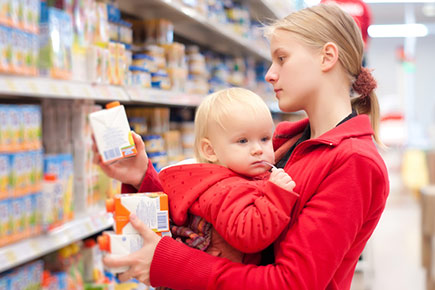
The WHO code
The International Code of Marketing of Breastmilk Substitutes (the WHO Code) was endorsed in 1981 by the World Health Assembly (WHA). The WHO Code is intended to protect babies, mothers and health professionals from inappropriate marketing of breast milk substitutes, feeding bottles and teats. Worldwide countries vary in the extent to which they have adopted the Code. Australia uses a voluntary, self regulatory code of conduct with manufacturers and importers of infant formula, rather than legislation, to enact the Code.
Overview of the Code
The Code and resolutions:
- Ban all advertising and promotion of products under the scope of the Code to the general public.
- Ban samples and gifts to mothers and health workers.
- Require information materials to advocate for breastfeeding, to warn against artificial feeding and not contain pictures of babies or text that idealise the use of products.
- Ban the use of the health care system to promote products
- Ban free or low-cost supplies of products.
- Allow health professionals to receive samples but only for research purposes.
- Demand that product information be factual and scientific.
- Ban sales incentives for products and contact with mothers.
- Require that labels inform fully about the correct use of infant formula and the risks of misuse.
- Require labels to not discourage breastfeeding.
Acknowledgement - International Code Documentation Centre, 2009. Code Essentials 3: Responsibilities of Health Workers under the International Code of Marketing of Breastmilk Substitutes and subsequent WHA resolutions.
Aim and scope of the WHO Code
The WHO Code aims to protect and promote breastfeeding and ensure proper use of breast milk substitutes on the basis of adequate information and through appropriate marketing and distribution. The WHO Code is intended as a minimum requirement for responsible marketing in all countries.
The WHO code applies to:
- The marketing of breast-milk substitutes and other milk products when marketed or otherwise represented to be suitable as a partial or total replacement of breastmilk. This includes infant formula, follow-on formula and toddler milks (marketed as suitable to replace breast milk up to two years).
- Other products related to bottle feeding including feeding bottles and teats.
- The quality and availability of these products and to information concerning their use.
Read a full description of the Code
WHA Resolutions
The WHO Code has been further clarified, and certain provisions extended, through subsequent resolutions to the Code made by the World Health Assembly. Subsequent resolutions hold the same weight as the Code and should be read with the Code. These resolutions enable the Code to keep up-to-date with marketing trends and scientific knowledge. Recent WHA resolutions have urged member states to:
- Strengthen implementation of the WHO Code.
- Avoid all conflicts of interest.
- End all forms of inappropriate promotion of foods for infants and young children.
- Not permit nutrition and health claims on foods for infants and young children.
View a summary of subsequent resolutions
Australia's response to the WHO Code
Australia was a strong supporter of the WHO Code and one of the first countries to vote for the adoption of the Code. Implementation of the WHO Code in Australia was planned to include:
- A self-regulatory agreement for importers and manufactures of infant formula (Marketing in Australia of Infant Formula agreement)
- Guidelines for bottle and teat manufacturers
- Guidelines for retailers
How Australia has implemented the WHO Code
Australia has implemented the WHO Code through:
- Development of Infant Feeding Guidelines for Health Workers
- Development of the Marketing in Australia of Infant Formulas: Manufacturers and Importers Agreement (MAIF Agreement)
- Inclusion in the Food Standards Australia New Zealand Code of mandatory labelling and composition provisions for infant formula consistent with the Code
To date the planned guidelines for bottle and teat manufacturers and guidelines for retailers have not been developed.
Australia should fully implement the WHO Code
The WHO Code is intended as a minimum standard for responsible marketing in all countries. Australia has not yet met this minimum standard.
In Australia, the scope of the MAIF Agreement is limited to infant formula (suitable to 12 months), and is therefore not consistent with the broader scope of the WHO Code (breast milk substitutes up to 24 months).
Sophisticated marketing techniques for products outside the scope of the MAIF Agreement undermine the intent of the WHO Code.
The WHO Code and subsequent resolutions remain at least as relevant today, if not more so, three decades on. Changes in technology and scientific advances have paved the way for more sophisticated and diverse marketing of breast milk substitutes.
The World Health Assembly as recently as 2012 urged member states to strengthen legislative, regulatory and/or other effective measures to control the marketing of breast milk substitutes.
Australia has not met this call to action. Instead, despite recommendations, no progress has been taken to strengthen the MAIF agreement or complete the original implementation plan for Australia's response to the WHO Code.
Health workers need to understand their responsibilities under the WHO Code
Over a third of the WHO Code is addressed directly to health workers. This is necessary because most of the marketing of infant formula is carried out through the health system and targeted at health workers. Regardless of measure adopted by government to implement the WHO Code, allhealth workers need to understand their responsibilities under the Code
148
The WHO Code has been adopted at a national level in some form by 148 countries
Are you a parent needing help?
Click here to visit the Australian Breastfeeding Association website for information and support


